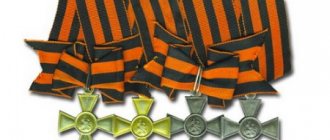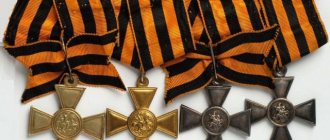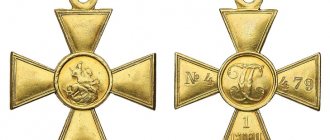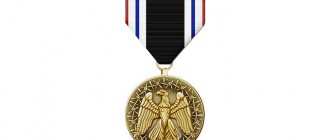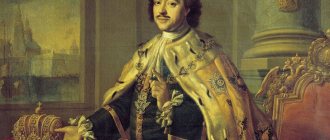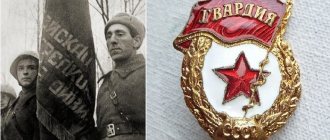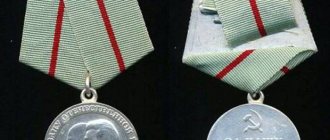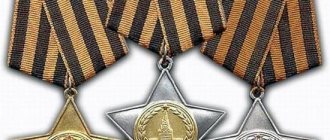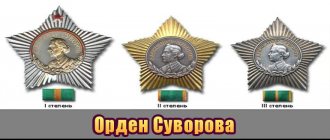IVAN TYULENEV (1892 - 1978)
Origin.
Son of a soldier.
Rank, place of service.
Dragoon, junior non-commissioned officer of the 5th Dragoon Kargopol Regiment.
Merits.
Cross IV degree - for distinction in battle on September 11, 1914, when, “being on the move near the village of Kholupki-Sechka surrounded by the enemy, he broke through the enemy chains and joined the squadron, giving valuable information about the enemy and his rear”1.
Cross III degree - for daring reconnaissance on the Bzura River on March 15, 19152.
Cross of the 3rd degree, replaced by a cross of the 2nd degree - for the fact that on July 14, 1915, together with two colleagues, they attacked a German patrol, hacked 11 people and took three prisoners3.
Cross III degree - awarded on November 6, 1915 by Grand Duke Georgy Mikhailovich in memory of the anniversary of the war4.
Cross of the 1st degree - awarded in early February 1917.
In April 1917, he donated all the awards to the revolution fund.
Career
. He took the side of the Bolsheviks. He entered the Academy of the General Staff of the Red Army, where he met the legendary Chapaev. He served with Budyonny, participated in the suppression of the Kronstadt and Tambov uprisings, and commanded a cavalry brigade and division. In 1921 he became a twice “Red Banner” - a holder of two Orders of the Red Banner.
He commanded a brigade, a division, and inspected cavalry in the North Caucasus District. In 1938 he was appointed commander of the troops of the Transcaucasian Military District. In 1940, he became one of the first Soviet army generals (besides him, only G.K. Zhukov and K.A. Meretskov received this honor).
The beginning of the Great Patriotic War was met by the commander of the Moscow Military District.
1941-1945.
On the first day of the war, he led the Southern Front, which defended Soviet Moldova. At the end of the first military summer, in the battles near Dnepropetrovsk, he was seriously wounded, after recovering from which he received an order to form 20 reserve divisions in the Urals within two months. Stalin signed the mandate for this at a critical moment for the country, October 13, 1941, when the Germans were rushing to Moscow.
Later he commanded the Transcaucasian Front and was able to prevent the Nazis from breaking through to the strategically important fields of Grozny and Baku oil. For many years, Tyulenev's merits remained unrecognized. Once in his heart he said: “Probably, we should have surrendered the Caucasus and then liberated it. Then the assessment of the activities of the front command would have been higher.”5
He became a Hero of the Soviet Union only in 1978, on the anniversary of the Red Army (the 86-year-old veteran became the oldest Hero). Six months later he died.
STROKE TO THE PORTRAIT
In January 1964, his son-in-law and daughter gave Tyulenev a set of St. George's crosses purchased from collectors for his birthday, on which the engraver engraved the numbers of those that belonged to Tyulenev. The following year, Tyulenev donated this set to the Historical Museum6.
St. George's Cross and its cavaliers. List
The history of the appearance of the St. George Cross award goes back to the beginning of the 19th century. On February 25, 1807, the Order of St. George was established; it was awarded to non-commissioned officers, soldiers and sailors for feats accomplished “on the battlefield, in the defense of fortresses and on the waters . In 1913, this highest soldier's award officially became known as the Cross of St. George. In the article we will look at the different degrees of this award and provide a list of the most famous holders of the St. George Cross.
Cross size: 34 mm by 34 mm. Material: until 1916, 900-karat gold was used, later 500-karat gold plated with 900-karat gold, later “yellow” metal Estimated price: from 700,000 rubles
From 1914 to 1917, about 33 thousand awards were given
Despite the fact that this is a reward of the Russian Empire, with the cessation of its existence, the cross itself did not stop its history. Later, the award was given to White Guard soldiers and officers for their exploits in battles with the Bolsheviks. Moreover, it is still a state award of the Russian Federation.
Its characteristics are the same as the cross of the first degree. But with the coinage of the word - “2nd step.” Cross size: 34 mm by 34 mm. Material: until 1916, 900-karat gold was used, later 500-karat gold plated with 900-karat gold, later “yellow” metal Estimated price: from 200,000 rubles
From 1914 to 1917, about 65 thousand awards were given
Cross size: 34 mm by 34 mm. Material: silver before 1916, then “silver” metal Estimated price: from 15,000 rubles
From 1914 to 1917, about 289 thousand awards were given
Its characteristics are the same as the cross of the first degree. But with the coinage of the word - “4 steps.” Cross size: 34 mm by 34 mm. Material: silver before 1916, then “silver” metal Estimated price: from 15,000 rubles
From 1914 to 1917, about 1 million 200 thousand awards were given
Note that in 1992, the “St. George Cross” insignia was restored in the Russian Federation
Throughout history, about 2 thousand people became full cavaliers (holders of all four degrees), about 7 thousand were awarded the 2nd, 3rd and 4th degrees. Most awards were received during the Russo-Japanese War of 1904-1905. In the 19th century, the insignia of the Military Order was awarded to:
- The first female officer of the Russian army, participant in the Patriotic War of 1812, adjutant-messenger of Kutuzov - Nadezhda Andreevna Durova. She was awarded for saving the life of an officer in the battle near Gutstadt; in the lists of gentlemen she is listed under the name of cornet Alexander Alexandrovich Alexandrov.
Monument to Nadezhda Andreevna Durova - For the battle of Dennewitz in 1813, another woman named Sophia Dorothea Frederica Kruger , a non-commissioned officer from the Prussian Borstell Brigade, received the St. George's Cross. Sofia was wounded in the shoulder and leg in the battle; she was also awarded the Prussian Iron Cross, 2nd class.
- The future Decembrists M. I. Muravyov-Apostol and I. D. Yakushkin, who fought at Borodino with the rank of ensign, which did not give the right to an officer’s award, received St. George’s Crosses No. 16697 and No. 16698.
Among the most famous cavaliers of the soldier's George are the famous character of the First World War, Cossack Kozma Kryuchkov and the hero of the Civil War Vasily Chapaev - three St. George's Crosses
Vasily Chapaev
- Soviet military leaders were full holders of the soldier's St. George Cross: A. I. Eremenko , I. V. Tyulenev , K. P. Trubnikov , S. M. Budyonny . Moreover, Budyonny received the St. George Crosses even 5 times: the first award, the St. George Cross of the 4th degree, Semyon Mikhailovich was deprived by the court for assault on his senior rank, the sergeant. Again he received the 4th degree cross. on the Turkish front, at the end of 1914. St. George's Cross, 3rd class. was received in January 1916 for participation in the attacks near Mendelij. In March 1916, Budyonny was awarded the 2nd degree cross. In July 1916, Budyonny received the St. George Cross, 1st degree, for leading 7 Turkish soldiers from a sortie behind enemy lines with four comrades.
- Of the future marshals, Rodion Malinovsky was awarded three times (two of them with a cross of the 3rd degree, one of which became known after his death), and non-commissioned officer Georgy Zhukov and junior non-commissioned officer Konstantin Rokossovsky .
- The future Major General Sidor Kovpak , during the Great Patriotic War, was the commander of the Putivl partisan detachment and a formation of partisan detachments in the Sumy region, which later received the status of the First Ukrainian Partisan Division.
- She became a famous Knight of St. George during the First World War. Maria Bochkareva. In 1920, she was shot by the Bolsheviks.
Maria Bochkareva - The last Knight of St. George during the Civil War is considered to be 18-year-old sergeant P.V. Zhadan , for saving the headquarters of the 2nd Cavalry Division of General Morozov.
KONSTANTIN NEDORUBOV (1889 - 1978)
Origin.
From the Don Cossacks.
Rank, place of service.
Cossack, sergeant of the 15th Don Cossack General Krasnov of the 1st regiment.
Merits.
Cross III degree - for the battle near Przemysl in December 1914, when he single-handedly captured 52 Austrians.
Cross III degree - for the attack on Austrian fortifications near Balamutovka and Rzhaventsy on April 27, 1915. Then the Russian troops overcame three rows of wire fences and burst into the enemy trenches, where a fierce hand-to-hand battle broke out. The Austrians were driven out of their positions, capturing eight officers, about 600 soldiers, three machine guns and two guns7.
Cross IV degree - for the same battle, when he was able to scatter an enemy company and capture a machine gun8.
Cross II degree - for the Brusilov breakthrough.
Cross of the 1st degree - for the capture of the enemy division headquarters together with the general. Apparently, we are talking about a partisan raid on the village of Nevel on the Pripyat River on the night of November 14-15, 1915. According to intelligence data, the German headquarters was located in the village. The partisans attacked the village from different directions, throwing hand grenades at the enemy and causing incredible confusion. In an hour-long hand-to-hand battle, many German soldiers and officers were exterminated. They managed to capture several officers and the head of the 82nd German Reserve Infantry Division, General Karl Friedrich Siegfried Fabarius. It was decided to take the general to corps headquarters, but he managed to shoot himself.
Career.
During the Civil War, the Cossack Nedorubov rushed between the Reds and the Whites, like Sholokhov’s Grigory Melekhov. In the end, he chose the Bolsheviks, fought heroically for them, and even received red revolutionary trousers as a reward.
During the period of collectivization, he allowed starving collective farmers to use leftover grain for food after sowing. He was convicted of abuse of office. He received ten years in the camps. He worked on the construction of the Moscow-Volga canal and was released early for shock labor.
1941-1945.
In the fall of 1941, he formed and led a squadron of Cossack volunteers. He served with his 17-year-old son. The squadron carried out daring cavalry raids on the enemy; Nedorubov’s fighters destroyed 200 Nazis near the Kushchevskaya station alone, and the same number near the village of Maratuki. My son was seriously wounded in the battles. Nedorubov himself, who was already over fifty, personally destroyed at least a hundred Nazi soldiers. The squadron launched an attack with the words: “Forward, for the Motherland, for Stalin, for the Free Quiet Don!” At the front he joined the party.
In October 1943 he was awarded the title of Hero of the Soviet Union. Nedorubov met the Victory Day as a guard captain, had 11 wounds and a severe concussion. Despite this, he took part in the Victory Parade and even attended a reception with Stalin.
He died in 1978, a few months before his 90th birthday.
STROKE TO THE PORTRAIT
He wore the Star of the Hero of the Soviet Union at the front along with the Crosses of St. George.
The most famous holders of the St. George Cross
St. George's Cross - an honorary badge of military valor in Tsarist Russia warways
During the existence of the St. George Cross, more than 3,500,000 people were awarded it, although the last 1.5-2 million are quite controversial, since they were often awarded not according to merit during the First World War. Many holders of the Order of St. George became famous not only for receiving this award, but are also historical figures:
- The famous Durova, or “cavalry maiden,” who served as the prototype for the heroine from the “Hussar Ballad,” was awarded the St. George Cross for saving the life of an officer;
- The Decembrists Muravyov-Apostol and Yakushkin also had St. George's crosses, which they received for military services in the battle of Borodino;
- General Miloradovich received this award from the hands of Emperor Alexander, who personally saw Miloradovich’s courage in the battle of Leipzig;
- Kozma Kryuchkov, who was a full holder of the Order of St. George, became a Russian hero during his lifetime. By the way, a Cossack died in 1919 at the hands of the Red Guards, defending the tsarist regime until the end of his life;
- Vasily Chapaev, who went over to the Red side, had 3 crosses and a St. George medal;
- Maria Bochkareva, who created the women's “death battalion,” also received this award.
Despite their popularity, it is now quite difficult to find St. George’s crosses. This is due to the fact that they were minted from gold (grades 1 and 2) and silver (grades 3 and 4). In February, the provisional government intensively collected awards “for the needs of the revolution.” During the Soviet period, when there was famine or blockade, many exchanged their rewards for flour or bread.
St. George's Cross - an honorary badge of military valor in Tsarist Russia warways
The memory of the St. George Cross was revived in 1943, when the Order of Glory was established. Nowadays, everyone is familiar with the St. George's Ribbon, which people who celebrate Victory Day decorate themselves with. However, not everyone knows that although the ribbon symbolizes the Order of Glory, its roots go much deeper.
MAXIM KOZYR (1890 - 1945)
Origin
. From peasants.
Rank, place of service.
Junior non-commissioned officer, ensign of the 419th Atkar Infantry Regiment.
Merits.
Cross III degree - for distinction in battle on July 16, 19179.
No documents were found about other awards, but the fact of being awarded all four degrees was confirmed by the hero himself: “For that war, in exchange for four soldiers’ St. Georges, they were given a gold cross with a bow and thereby promoted to lieutenant ensign”10.
Career.
He took the side of the Bolsheviks. In Civil War he was awarded the Order of the Red Banner. He completed the command courses and the Shot courses, rose to the rank of colonel, and became deputy division commander. The writer Konstantin Simonov remembered Kozyr’s words: “I have two passions in life - war and agriculture... After the war, I have no interest in being in the army. After the war, I want to start farming like an old man. Nah!..”11
1941-1945
. At the very beginning of the war, he lost his family. Later he told Konstantin Simonov about this, becoming the prototype of General Kuzmich in the novel “The Living and the Dead”:
“My family died in Brest-Litovsk. Both the chief of politics and the chief of staff of the family. Two bombs - right into the house where they lived, at night. As they were, undressed. They brought only scraps. They were buried later in Kobrin. Nope. I didn't go look. Flowers, they say, were brought to graves. Why didn't you go? It had an effect on me. The chief of staff, when he saw that his family was with him, shot himself. So, in general, I have only one mother-in-law left in my family, an old lady. He writes to me, by the way.”12
Before his death, the general did not find out that the Nazis had taken his wife and son to Germany, from where Kozyr’s relatives would return only after the Victory.
Near Brest, the assembled commanders elected Kozyr as temporary commander of the 4th Army, whose troops he was able to withdraw from encirclement.
He took part in the defense of Moscow and received several serious wounds. He himself spoke about this somewhat ironically (and perhaps doomedly): “I was wounded near Staraya Russa, seriously. Returned back to the front. Stood near Novgorod. The second time he was seriously wounded near Novgorod. This is the seventh, so far the last one. Three times in the World War, twice in the Civil War, twice in this one.”13
In May 1944, Maxim Evseevich became a Hero of the Soviet Union.
The soldiers adored the “soldier general” who never left the trenches, and he reciprocated. The life of the “old man,” as his colleagues called him behind his back, was cut short a couple of weeks before the Victory - on April 23, 1945, due to an error on the map, Kozyr’s Jeep slipped through the corps’ battle formations. The general died in battle in the city of Rajhrad in Czechoslovakia (according to other sources, he was captured and killed14). A day after the death of the general, when Rajhrad was taken by our troops, a car was found in a ditch, and in a garden nearby the bodies of the driver, adjutant, general and nurse.
STROKE TO THE PORTRAIT
Three of his brothers died in the First World War, the fourth in the Civil War. The ashes of Maxim Kozyr rest in the Olshansky cemetery in Prague - not far from the graves of the White Guards with whom he fought during the Civil War.
Vologda residents - participants in the First World War
100 years ago, the First World War began - a forgotten war, the Great or Second Patriotic War. This war, which required enormous effort from the Russian people and enormous expenses, shook up all layers of Russian society. Tens of thousands of Vologda residents were mobilized for this war. Thousands were killed, wounded, went missing, or died from wounds and disease.
The list of numbers of St. George's crosses has been compiled over many years of work based on archival materials, museum collections and private collections. Let us remember that the cross number was engraved on the reverse side of the cross. The illustration shows the number of the cross of Maxim Pavlovich Belyaev, a native of the Nesteferovskaya volost of the Veliky Ustyug district. Photo (ill. 1) courtesy of the Veliky Ustyug State Institute of Agricultural and Chemical Plants. This number is fourth in the list of numbers. By the number you can judge in what year the hero received this award - 8854 indicates that M.P. Belyaev received it in September 1914, which is confirmed by archival documents.
Il. 1
Il. 2
On ill. 2 you see the St. George Cross, also stored in the funds of the Veliky Ustyug Museum-Reserve. It belongs to a native of the village of Moseevo Pleso, Veliky Ustyug district, P. D. Moseyev. From the number engraved on the back of the cross - 1005169 - we can conclude that it was awarded in 1917. Pavel Dmitrievich is almost at the end of the list of crosses whose ownership has been established. The first part of the list includes those who were awarded the St. George Cross, 4th degree. The numbers are arranged in ascending order. Question marks following the last number indicate that the number is unknown, followed by a list of surnames in alphabetical order. The good thing is that the question marks are shrinking over time. Sometimes in archival files there are such incidents that led to a question mark after the cross number. In the cases devoted to the issuance of St. George's awards to relatives of killed lower ranks, there are forms in which it is written that St. George's crosses of the 4th degree should be sent to relatives in Nikolsky district, but the military clerks forgot to write the surname of the awarded. I present to the readers of “Vologda Collector” a list that is constantly updated and adjusted. It cannot claim absolute completeness. It is an appendix to the book “Vologda Region in the Shadow of the Cross of St. George”, which should be published this year. The list included natives of Vologda, Gryazovets, Kadnikovsky, Nikolsky, Velsky, Solvychegodsky, Yarensky, Ustsysolsky, Totemsky and Veliky Ustyug districts of the Vologda province, Kirillovsky, Cherepovets, Belozersky and Ustyuzhensky districts of the Novgorod province and Vytegorsky district of the Olonets province.
2994 – Evgeniev E. I. 5020 – Khomutinnikov M. 5510 – Kiselev V. 8854 – Belyaev M. P. 9515 – Kornev A. 10541 – Kozlov P. 14947 – Vityazev P. 15347 – Osipov K. 23101 – Kamensky V. N. 26758 – Kuzmin V. 27428 – Amosov N. A. 27720 – Iosh V. 28715 – Evlashin 30086 – Levshin M. G. 30529 – Baev V. I. 31691 – Shoroshikhin K. 36253 – Musatov V. I. 36495 – Gladinov A. 36501 – Fokin L.V. 36531 – Krasotkin F.G. 36538 – Kulikov I.A. 36567 – Chekulaev N. 36604 – Semenov I.S. 36606 – Solovyov S.E. 36648 – Plotnikov K.K. 36713 – Nedalov A.P. 36741 – Potemkin D.P. 36745 – Borisov I.A. 38101 – Smirnov V.M. 38132 – Kozlov I.I. 38167 – Egorov Y.K. 38178 – Lisin G.P. 40335 – Emelyanov I. A. 47206 – Sokolnikov 47885 – Osipov G. 48222 – Dutin A. E. 48361 – Vdovichev M. I. 48373 – Osin F. 48652 – Udarov E. S. 49149 – Kremlev Y. A. 52550 – Borisov S. 52915 – Postnikov V. 53151 – Golounin N. 53326 – Krylov D. Ya. 53416 – Kuritsyn I. 53568 – Pugachev M. 53753 – Bechin P. 57994 – Furov K. 58194 Shortov S. O. 59497 – Ponikarovsky N. A 61607 – Yakhontov N. I. 62127 – Ruchev I. P. 62312 – Parygin A. P. 63090 – Komarov P. 63384 – Avvresov 65640 – Vaneev A. E. 71083 – Obukhov A. F. 717415 – Kirov T. 74270 – Mokretsov F. A. 74319 – Guryev V. 74533 – Chumovitsky S. 74458 – Aleksandrov A. G. 74530 – Filimonov S. F. 74533 – Chumovitsky S. 74594 – Dyatkinsky A. 74650 – Burushkov A. P. 74757 – Chezhin G. V. 75157 – Kozulin A. 75163 – Dolgin E. A. 75164 – Sheshkov G. A. 75168 – Kuznetsov P. S. 75622 – Gromov A. 75625 – Smirnov V. 75637 – Kurzenev A. D. 75645 – Osokin A. 75836 – Lobanov K. A. 77096 – Teplyakov A. S. 77720 – Bodrov A. I. 77915 – Golovin A. 77930 – Nevzorov P. F. 80566 – Girushev V. 81532 – Legkikh P. S. 93678 – Tyurin I. P. 97589 – Malyshev N. A. 99257 – Osinovatikov A. 107583 – Demyanovsky F. P. 116305 – Ryabini V. Ya. 120667 – Kozlov V. G. 120895 – Kapralov V. I. 121072 – Dityat’ev A. N. 125115 – Malyshev I. I. 128221 – Bragin I. N. 138740 – Borovikov I. P. 139170 – ? 139171 – ? - Sukhanov P. I. 160180 – Markov M. F. 168626 – Shadrin D. 174653 – Drankovsky N. N. 175584 – Belykh P. 181082 – Shchapkov I. P. 185893 – Zaitsev P. S. 186031 – Kalinin V. N. 170653 – Shiryaev I. 170721 – Toporov A. 172738 – Krikunov V. 175522 – Zagorodsky F. 177054 – Nozikov 179776 – Veprev I. 181909 – Malkov I. M. 185719 – Khudozhilov S. S. 185893 – Zaitsev P. S. 186732 – Rulev F. 186727 – Murin K. 189780 – Baranov M. 190169 – Smolin S. 190207 – Solovyov I. 190224 – Zhidenev P. 190242 – Kudryashov V. 190257 – Voronov V. 190270 – Vorobiev A. 194207 – Alelyukhin F V. 195980 – Sherkunov L. 198637 – Rachkov 202164 – Teltevsky M.I. 204685 – Bugrinov A. 206331 – Chistyakov 206445 – Erin V. 206423 – Sukhanov V.M. 215159 – NoskovA. V. 221935 – Shutov A. I. 221939 – Shchipkov V. 222545 – Zakharov P. F. 222947 – Derevyagin A. 222322 – Kashin S. A. 235289 – Kubarev A. I. 235454 – Kalmykov N. S. 235493 – Tikhomirov I. 235604 – Soloviev I. 236385 – Polyakov 236417 – Krestsov P. 237089 – Molkanov A. A. 237394 – Karpov N. I. 238399 – Levashev N. 241200 – Aleksakhin V. N. 241205 – Sosnin A. D. 241751 – Andryushichev N. 242558 – Omrinov M. 244418 – Kozlov V. 254451 – Belyaev Ya. P. 255280 – Bryukhanov A. 274643 – Titov I. L. 281963 – Malafeevsky F. 282299 – Korolkov M. 290259 – Pyatovsky S. A. 290295 – Druzhini nskiy I V. 291383 – Bolokov M. 291426 – Korolev 299437 – Lyamin M. V. 299468 – Surovitsyn G. P. 299469 – Zheglov S. M. 299705 – Matulov M. A. 299770 – Smirnov G. I. 301210 – Marakazov I f. 306085 - Gryaznov I. 306100 - Belyaev I. Ya. 307218 - Rumyantsev I. 310854 - Glebov V. 311054 - BAMDASOV V. 312784 - Seleznev S. L. 3132227 - Nosov I.I. 313527 - Pustygin A. 316259 - Bragin with 318378 – Sivkov A. N. 327685 – Dolganov A. 327724 – Kolosov N. 327777 – Boytsov S. F. 327858 – Lasukov A. V. 328129 – Nizkovsky I. E. 328285 – Pertsev P. 328238 – Pronichev 328279 – Gusev S. 328291 – Sharapov F. 328303 – Kazakov I. E. 328307 – Manakov A. 328316 – Kozyrev 328322 – Krasotin M. 328324 – Svinev A. 328328 – Serov I. 328350 – Kovshikov V. 328351 – Sipyagin N. 328363 – Alliluyev A. 328372 - Moskvinov V. 328383 - Khmylov A. G. 328384 - Konovalov A. 328385 - Shirkunov M. F. 328393 - Egorov A. 328400 - Fufin V. 328427 - Mezenev N. 329583 - Orlov G. 3333773 - Shestakov - Shestakov G. 335714 – Stoletov D. 341945 – Bovykin A. A. 344085 – Pripisnoy P. 344152 – Konoplev A. 344473 – Tsvetkov I. 346045 – Grigoriev D. G. 347004 – Smirnov M. 358719 – Cherepyagin V. 371182 – Shishkin P V. 377720 – Bodrov A. I. 378060 – Bukovsky M. A. 382771 – Rumyantsev P. 398347 – Buslanov A. A. 404764 – Khoroshev P. M. 405712 – Shilov A. 409067 – Palkin A. 409998 – Yudin A 411772 – Maltsev A. 411836 – Salamatov D. 416550 – Kozlov D. 421410 – Popov I. A. 421418 – Karelin I. 421790 – Belousov P. F. 422035 – Kursov A. 423440 – Lobantsov V. A. 426026 – Sokolov A. N. 426609 – Kuznetsov D. 428493 – Kuchin I. M. 429644 – Burdaev A. 440625 – Akulovsky M. A. 446576 – Drozdov S. S. 455814 – ? 456853 - Adeev T.E. 450221 - Yenin V. 450281 - Maltsev A.F. 450752 - Tugolukov A.P. 451296 - Petukhov A. 455380 - Navolotsky 456549 - Simakov N.P. 456853 - Adeev T 458889 - Levichv P. 460579 – Uvarov K. 461593 – Ignatov S. 462374 – Smolnikov V. 462391 – Svinkin I. 465625 – Karmanov I. 465687 – Kapustin A. 466581 – Pozdnyakov R A. 467652 – Kolmakov A. 469529 – Sokolov 470142 – Lyapunov Ya. A . . 477773 – Grigoriev V. G. 477937 – Tarutin V. M. 479029 – Trenin E. P. 480373 – Osin F. 480477 – Gromov F. E. 481377 – Isakov P. 485527 – Gagarin A. V. 486581 – Byvakin S. - Sazhen E. 495571 – Zarubin A. A. 496018 – Sorokin N. K. 496073 – Polyakov V. T. 496094 – Bystrov F. K. 496482 – Ogarkov A. 506130 – Mityushev S. 511002 – Kustov I. 511056 – Belozerov G. I. 511133 – Chetsky A. 511233 – Enichurin D. A. 511292 – Kholopov A. P. 511292 – Kholopov A. II. 511315 – Romashev N.K. 516172 – Kutykin V. 518883 – Pestovsky N.N. 521223 – Tigin K. 524864 – Rogozin K. 524466 – Lyutaev A. 527215 – Davidov P. 527586 – Smirnov A. 537956 – Sokolov A. S. 538340 – Gusikhin M. S. 538373 – Avakumov M. N. 543212 – Vorobyov A. 543502 – Lyapunov Y. A. 543976 – Neustupov M. 552043 – Shprygov I. D. 564159 – Suranov V. F. 568518 – Chuchin M. N. 573020 – Novoseltsev I. I. 573552 – Rozhkov K. V. 574533 – Bulanov A. 582270 – Belyaev I. I. 585327 – Starostin T. S. 587419 – Chelpanovsky N. 594368 – Maslogv V. V. 595423 – Serdtsov A.P. 611683 – Volokhov M. 611856 – Serebryakov V.I. 650180 – Proshin P. 650538 – Treskin N.S. 658122 – Vakhrameev I.V. 660126 – Soloviev E.P. 660155 – Nikitin V.K. 662109 – Kurilov N.F. 665815 – Yugov Y.M. 670634 – Gulyaev N. 677363 – Mazaev I. 677633 – Larionov A.I. 692881 – Tikhomirov A. 717353 – Gavshin 717627 – Verichev I. 717641 – Protasov I.P 719114 – Mikheev 722405 – Kalinin I. 726760 – Marin I. 732909 – Bobein A. 734379 – Savin A. A. 742225 – Senyukov G. 742763 – Kapostin I. 753750 – Grishenkin I. B. 754988 – Zinin I. V. 757546 – Glarin N.V. 757869 – Karmanov I.P. 757895 – Petrovsky K.D. 759817 – Bochkareva M.L. 766067 – Butyrev M. 776794 – Mokhov M.A. 777387 – Kholmogorov M.A. 778083 – Bessonov F. 778424 – Krylov A. 779788 – Golikov M. 780467 – Golyshev E. 783892 – Aksenov A. G. 784875 – Vlasov P. I. 785590 – Uvarov D. A. 792100 – Voryushin P. A. 792115 – Ponomarev B. R. 794797 – Borisov F. 794841 – Belyaev A.I. 801890 – Oparin I.M. 809344 – Bolshakov P. 810115 – Krivoshapkin A.A. 821879 – Likhomanov N.P. 831013 – Manin E.I. 832247 – Myatlin M. 862730 – Bolshakov V. 863674 – Gorchakov P. A. 863722 – Belyaev A. 875649 – Kashin G. 888235 – Mochaygin S. 889265 – Surovtsev F. E. 889422 – Dernyatin I. K. 898969 – Zyrin F. 911509 – Dulavkin V. A. 934238 – Lebedev E. 950470 – Markov M. P. 950652 – Glybin P. 952519 – Potolitsyn A. 956534 – Sidorov A. A. 958432 – Yamov S. P. 960949 – Durakov A. 968796 – Gavrintsev Z 996601 – Dryankov N. M. 997136 – Moskvin N. 1005469 – Moseev P. D. 1005735 – Lyukhanov A. 1124321 – Vanintsev N. 1129865 – Kostrikov .S. 1179776 – Veprev I. ? - Alekseev? - Aleshin P.T.? – Atkin S.I.? - Baev P.N.? – Bayborodin P.A.? – Barulin F. ? – Basharin F.M.? – Belozerov I.A.? – Belyaev V.E.? - Belyakov A. ? – Bobrov I.A.? – Bolotov S.S.? – Bolshakov A.I.? - Bragin I.P.? - Bryzgalov? – Bryzgunov I. Ya.? - Bykov G.V.? – Bykovsky N.A.? – Varakin F.D.? – Warnaving G. ? – Veresov N.I.? – Veselov M.F.? – Virin I.A.? – Vorobiev S.I.? – Gerasimov G. ? – Gonov M. ? – Grachev M.V.? – Nepomiluev M.P.? – Voronin M.N.? – Vorsin A.S.? – Ganyukov G.V.? – Garmanov S.N.? – Gorbunov I.L.? – Gorbunov M.A. ? – Degtev V.I.? – Demidov V.M. ? – Dolinin M. ? – Evdokimov N.A.? – Egorov I.A.? – Edalov A. ? – Ekimov N.V.? - Ench Ya.? – Ershov I.E.? – Zhabreev I.P.? – Zhilin A.D.? – Zhuravin A.P.? – Zabelin M. ? – Zanin V.G.? – Zaonegin D.A.? – Zarubalov F.S.? – Zakharov S.A.? – Zubov P.I.? – Zorov E.M.? – Zubkov P.A.? – Zykov V.? – Yalesky K.L. ? – Ivanov N.I..? – Ivkin D.B.? – Iovelev S.V.? – Kabakov N.A.? – Kazadanov N.P.? - Klaptenko? – Kobatov N.A.? – Koptyaev A.G.? - Kokushkin N.? – Konovoalov I.P.? – Konstantinov V.E.? – Koptyaev S.A. ? – Kopytsev G. ? – Kormanovsky D. D.? – Kornev A.V.? – Koskov S. ? – Kochkin K. ? – Krikhnyak K.? – Kruglov M.S.? – Krutikov N.S.? – Kuvaev K.A.? – Kuvylkin V. ? – Kudryavtsev I.V.? – Kudryavtsev N.F.? – Kuznetsov I. ? – Kuzmichev A. ? – Kurilov A.G.? – Kuchik I.A.? – Kyzrodev I.G.? – Lagirev A.S.? – Lazarev A. ? – Leshukov P.D.? – Lukichev F.M.? – Lushkov P.S.? – Makarov I.M.? - Manichev? - Makhin N.A.? – Muromtsev A.M.? – Mymrin F.A.? – Nelaev A.N.? – Nenastyev P. ? – Nenomiluev M.P.? – Neustrosv V.A.? – Nefediev M.I.? – Noskov M.S.? – Nuzhin V.K.? – Obichkin E.D.? – Obukhov S.D.? – Oshurkov N.I.? – Palamodov N.M.? – Pakhtusov A.V.? – Penyugalov I.V.? – Petrov K.P.? – Petukhov M.A.? – Pikunov V.P.? – Pimenov A.T.? - Pinegin A.? – Pinegin D.V.? – Poluyanov G.I.? – Pomerantsev F.A. ? – Ponomarev A.I.? – Ponomarev P.T.? – Popov D. A.? – Provorov N. ? – Deserted V.M.? - Pyatovsky Ya. G.? – Rozhin Ya. 3. ? – Rupakov V.F.? – Ryumin G. A.? – Sashin A.I.? – Sivkov I.F.? – Tarbaev V. A. ? – Saburov A. ? – Savelyev V.P.? – Svinin I.S.? – Serov I.I.? – Serkov N. ? – Smirnov V.E.? – Smirnov G. ? – Smirnov M.A. ? – Smirnov P.T.? - Sovetov P. A? – Sokolov L. R? – Sokolov P.M.? – Sokolov F.T.? – Soloviev A. ? – Stoletov P.K.? – Stupkin I. ? – Tarbaev E.M.? – Tarasov B.A.? – Teleshov D.V.? – Timofeev A.T.? – Trudov A.I.? – Tyapkin M.A.? – Khvostov F.S.? – Khomyakov M.A. ? – Khrabrov P.A.? – Khrabrov S.V.? – Tsivilev N. ? – Tsypin F.V.? – Chernyaev A.I.? – Chirkov I.P.? – Sharov I.N.? – Shemyakin I.V.? – Shipitsyn 3. N. ? – Shirkunov N.K.? – Shitikov A.M.? – Shmonin V.I.? – Shulgin I.A.? – Shchenetkin M.I.? — Shchuchev A. S.
Source: Demidova E.L. List of numbers of St. George's crosses, which were awarded to natives of the Vologda region during the First World War. Part 1. St. George's Cross, 4th degree / E.L. Demidova // Vologda collector. – 2014. – No. 37. – pp. 20-26.
GRIGORY AGEEV (1902 - 1941)
Origin.
From the workers.
Rank, place of service.
Senior non-commissioned officer, duty station unknown. He ran away to war as a 12-year-old boy.
Merits
. Cross IV degree - for climbing into a German trench, stealing a machine gun with belts and delivering the trophy to his own.
Cross III degree - for the capture of a German officer and orderly.
Two more crosses - based on the totality of merit for prolonged battles.
According to other sources, there were three15 crosses; no documentary evidence was found.
Career.
He took the side of the Bolsheviks. During the Civil War, he served as a liaison officer for partisan detachments in German-occupied Ukraine, as a political instructor, and as a military commissar. He was wounded three times.
He worked as a secretary of the district committee, editor of a large-circulation newspaper, restored the mines of Donbass, built the Dnieper Hydroelectric Power Station, and carried out collectivization. He conscientiously carried out any instructions from the party leadership. In 1939, he was sent to the village of Chegdomyn, 630 km from Khabarovsk, to create a fuel base for the future BAM. Already in 1941, the Chegdomyn mines provided the country with its first coal. For the construction of mines, Ageeva was awarded the Order of the Red Banner of Labor.
1941-1945.
He became one of the founders of the Tula people's militia, forming destruction battalions from miners. When the enemy approached the borders of the Tula region, he led one of the detachments. In the first battle he showed himself to be a skilled commander. But during the Great Patriotic War, life in the infantry was short. Ageev's combat life lasted only 11 days.
Ageev took his last battle on October 30, 1941, on the near approaches to Tula. During a sortie for the wounded, the eighth in a row, the hero was hit by a machine-gun burst. He was buried with military honors at the All Saints Cemetery in Tula.
In 1965, on the occasion of the 20th anniversary of the Victory, he was posthumously awarded the title of Hero of the Soviet Union.
STROKE TO THE PORTRAIT
He ran away to World War I as a 12-year-old boy under the influence of a priest’s sermon. He left a note for his family: “Don’t look for me, I’ll show up myself.”
IVAN LAZARENKO (1895 - 1944)
Origin
. From peasants.
Rank, place of service
. Senior non-commissioned officer of the 107th Trinity Infantry Regiment
Merits.
In the lists of those awarded, junior and then senior non-commissioned officer of the 21st engineer battalion Ivan Lazarenko, who distinguished himself in battles with the Austrians, appears three times. Perhaps this is Ivan Sidorovich, but the place of service does not coincide with that known from the official biography of our hero. A photo attributed to Lazarenko with four St. George's crosses and a medal has also been preserved, but the code on the shoulder straps is 11, which also does not coincide with the known places of service of I.S. Lazarenko. So far these questions remain unanswered.
Career.
He took the side of the Bolsheviks. Commanded a platoon, squadron, detachment. He fought against the Ural and Don Cossacks, Czechoslovak legionnaires, Denikinites, Wrangelites and Makhnovists17. He was awarded the Order of the Red Banner.
At the end of Civil, he joined the party. Graduated from the Frunze Academy. Participated in the Spanish Civil War, and then in the Soviet-Finnish War.
1941-1945.
At the beginning of the war, he commanded the 42nd Infantry Division stationed in the Brest Fortress. Today we know how heroically the fortress held out. But in the summer of '41 this was not yet known. Then the notorious case arose against the command of the Western Front, in which the front commander, Hero of the Soviet Union, Army General Dmitry Pavlov, and six other generals were arrested and shot.
General Lazarenko was also arrested (he was not located directly in the Brest Fortress, where part of his division heroically fought). He was “lucky” - the execution was replaced by ten years in the camps with deprivation of rank, and in October 1942 he was released, given the opportunity to go to the front as deputy division commander with the rank of colonel.
From November 1943 he commanded the 369th Karachev Rifle Division. Future Marshal K.K. petitioned for the removal of his criminal record. Rokossovsky, who himself went through arrest before the war. Lazarenko's criminal record was cleared, but not rehabilitated. He was also reinstated to the rank of major general.
Participated in the famous Operation Bagration for the liberation of Belarus. He died in June 1944 in the battle for the village of Kholmy near Mogilev. He was buried in Mogilev. For skillful command of the division, exemplary performance of command assignments, courage and heroism, he was posthumously awarded the title of Hero of the Soviet Union.
Only in 2010, Lazarenko’s grandson achieved that the Military Collegium of the Supreme Court of Russia overturned the 1941 verdict against his heroic grandfather as not corresponding to the actual circumstances.
STROKE TO THE PORTRAIT
He donated his crosses of St. George to the Volga region famine relief fund.
HomeInsigniaSt. George Cross and the most famous St. George Knights of the Russian Empire
10/17/2018. CONTENTS.
1.Description of the St. George Cross
2.History of the St. George Cross
3. The most famous Knights of St. George
Among all the military awards in Russian history, the Cross of St. George occupies a special place. This badge of military valor is the most famous award of pre-revolutionary Russia. The Soldier's Cross of St. George can be called the most popular award of the Russian Empire, because it was awarded to the lower ranks (soldiers and non-commissioned officers).
Officially, this award was equivalent to the Order of St. George, established by Catherine the Great in the 18th century. The Cross of St. George had four degrees; according to the statute of the award, this badge of military distinction could only be received for courage on the battlefield.
This insignia lasted just over a hundred years: it was established during the Napoleonic Wars, shortly before the French invasion of Russia. The last conflict in which several million people received St. George's Crosses of various degrees was the First World War.
The Bolsheviks abolished this award, and the St. George's Cross insignia was restored only after the collapse of the USSR. During the Soviet period, the attitude towards the St. George Cross was ambiguous, although a huge number of St. George cavaliers fought on the fronts of the Great Patriotic War - and they fought well. Among the holders of the St. George Cross are Marshal of Victory Georgy Zhukov, Konstantin Rokossovsky and Rodion Malinovsky. Full Knights of St. George were the Soviet Marshal Budyonny and military leaders Tyulenev and Eremenko.
The legendary partisan commander Sidor Kovpak was awarded the cross twice.
Knights of the St. George's Cross received monetary incentives and were paid a pension. Naturally, the largest amount was paid for the first (highest) degree of award.
Description of the St. George's Cross
The order's insignia was a cross with blades widening towards the end. In the center of the cross was a round medallion, on the front side of which was depicted St. George slaying a serpent. The letters C and G were applied to the reverse side of the medallion in the form of a monogram.
The crossbars on the front side remained clean, and the serial number of the award was printed on the reverse. The cross had to be worn on a black and orange St. George's ribbon (“the color of smoke and flame”).
The Cross of St. George was highly respected in the military environment: lower ranks, even having received the rank of officer, proudly wore it among their officer awards.
In 1856, this award badge was divided into four degrees: the first and second were made of gold, the third and fourth - of silver. The degree of the award was indicated on its reverse. The award of the distinction was carried out sequentially: from the fourth to the first degree.
History of the St. George Cross
The Order of St. George has existed in Russia since the 18th century, but this order should not be confused with the soldier's Cross of St. George - these are different awards.
In 1807, Russian Emperor Alexander I was presented with a note proposing the establishment of an award for lower ranks who distinguished themselves on the battlefield. The emperor considered the proposal quite reasonable. Just the day before, a bloody battle took place at Preussisch-Eylau, where Russian soldiers demonstrated remarkable courage.
However, there was one problem: it was impossible to award lower ranks with orders. At that time, they were given only to representatives of the nobility; the order was not just a “piece of iron” on the chest, but also a symbol of social status, it emphasized the “knightly” position of its owner.
Therefore, Alexander I resorted to a trick: he ordered that lower ranks be awarded not with an order, but with the “insignia of the order.” This is how the award appeared, which later became the Cross of St. George. According to the emperor’s manifesto, only lower ranks who showed “undaunted courage” on the battlefield could receive the St. George Cross. According to status, a reward could be received, for example, for capturing an enemy banner, for capturing an enemy officer, or for skillful actions during battle. Concussion or injury did not give the right to a reward if it was not related to the feat.
The cross had to be worn on the St. George ribbon, threaded through the buttonhole.
The first cavalier of the soldier's George was non-commissioned officer Mitrokhin, who distinguished himself in the battle of Friedland in the same 1807.
Initially, the St. George Cross did not have degrees and could be issued an unlimited number of times. True, the badge itself was not reissued, but the soldier’s salary increased by a third. Corporal punishment could not be applied to holders of the St. George Cross.
In 1833, the insignia of the Military Order was included in the statute of the Order of St. George. Some other innovations also appeared: commanders of armies and corps could now award crosses. This greatly simplified the process and reduced bureaucratic red tape.
In 1844, the St. George Cross was designed for Muslims, in which St. George was replaced by a double-headed eagle.
In 1856, the St. George Cross was divided into four degrees. The reverse of the sign indicated the degree of the award. Each degree had its own numbering.
Over the entire history of the St. George Cross with four degrees, more than two thousand people became full holders of it.
The next significant change in the statute of the Military Order Insignia occurred on the eve of the First World War, in 1913. The award received the official name "St. George's Cross", and the St. George's Medal (a numbered medal for bravery) was also established. The St. George Medal also had four degrees and was awarded to lower ranks, military personnel of irregular troops and border guards. This medal (unlike the St. George Cross) could be awarded to civilians, as well as military personnel in peacetime.
According to the new statute of the insignia, the St. George Cross could now serve as a posthumous award, which was transferred to the hero’s relatives. The numbering of the award began again from 1913. In 1914, World War I began and millions of Russian citizens were drafted into the army. During the three years of the war, more than 1.5 million St. George Crosses of various degrees were awarded.
The first St. George cavalier of this war was the Don Cossack Kozma Kryuchkov, who (according to the official version) destroyed more than ten German cavalrymen in an unequal battle. Kryuchkov was awarded "George" of the fourth degree. During the war, Kryuchkov became a full Knight of St. George.
During the First World War, women were repeatedly awarded the Cross of St. George; foreigners fighting in the Russian army became its recipients.
The appearance of the award also changed: in difficult times of war, the highest degrees of the cross (first and second) began to be made of gold of a lower standard, and the third and fourth degrees of the award significantly lost weight.
The 1913 statute significantly expanded the list of acts for which the St. George Cross was awarded. This largely neutralized the value of this insignia. During the First World War, more than 1.2 million people became Knights of Yegoria. Judging by the number of recipients, there was simply mass heroism in the Russian army. Then it is not clear why these millions of heroes soon shamefully fled to their homes.
According to the statute, the cross was to be issued only for exploits on the battlefield, but this principle was not always followed. Georgy Zhukov received one of his St. George Crosses for shell shock. Apparently, the future Soviet marshal already in those years knew how to find a common language with his superiors.
After the February Revolution, the status of the St. George Cross was changed again; now it could also be awarded to officers after the appropriate decision of the soldiers’ meetings. In addition, this military insignia began to be awarded for purely political reasons. For example, the cross was awarded to Timofey Kirpichnikov, who killed an officer and led a mutiny in his regiment. Prime Minister Kerensky became a holder of two degrees of the cross at once, for “tearing down the banner of tsarism” in Russia.
There are known cases when entire military units or warships were awarded the Cross of St. George. Among others, this badge was awarded to the crews of the cruiser Varyag and the gunboat Koreets.
During the Civil War, soldiers and non-commissioned officers in White Army units continued to be awarded the Cross of St. George. True, the attitude towards awards among the White movement was ambiguous: many considered it shameful to receive awards for participation in a fratricidal war.
On the territory of the Donskoy army, George the Victorious on the cross turned into a Cossack: he was wearing a Cossack uniform, a hat with a hood, from under which his forelock protruded.
The Bolsheviks abolished all awards of the Russian Empire, including the Cross of St. George. However, after the start of the Great Patriotic War, the attitude towards the award changed. “George” was not allowed, as many historians claim, but the authorities turned a blind eye to wearing this sign.
Among the Soviet awards, the Order of Glory had an ideology similar to that of the soldier George.
Collaborators who served in the Russian Corps were also awarded the Cross of St. George. The last award took place in 1941.
The most famous Knights of St. George
Over the entire existence of this award, about 3.5 million St. George Crosses of various degrees have been issued. Among the holders of this insignia are many famous personalities who can safely be called historical.
Soon after the award appeared, the famous “cavalry maiden” Durova received it; the cross was awarded to her for saving the life of an officer.
The former Decembrists Muravyov-Apostol and Yakushkin were awarded the Crosses of St. George - they fought at Borodino with the rank of ensigns.
General Miloradovich also received this soldier's award for his personal participation in the Battle of Leipzig. The cross was presented to him personally by Emperor Alexander, who witnessed this episode.
A very famous character for his era was Kozma Kryuchkov, the first cavalier of the “George” of the First World War.
The famous division commander of the Civil War, Vasily Chapaev, was awarded three crosses and the St. George medal.
The holder of the St. George Cross was Maria Bochkareva, the commander of the women’s “death battalion” created in 1917.
Despite the huge number of crosses issued over the entire period of existence of this award, today this insignia is a rarity. It is especially difficult to buy the St. George Cross of the first and second degrees. Where did they go?
After the February Revolution, the Provisional Government issued a call to donate its awards to the “needs of the revolution.” This is how Georgy Zhukov lost his crosses. Many awards were sold or melted down during periods of famine (there were several during the Soviet period). Then a cross made of silver or gold could be exchanged for several kilograms of flour or even a couple of loaves of bread.
MIKHAIL MESHCHERYAKOV (1896 - 1970)
Origin
. From the workers
Rank, place of service
. Non-commissioned officer, ensign of the 550th Igumensky Infantry Regiment.
Merits.
Based on the materials of General Meshcheryakov’s accounting documents for the Soviet period, it is known that he was awarded four St. George Crosses18. Meshcheryakov received the crosses in a short time - in October 1915 he was drafted into the army, the next year he graduated from the Oranienbaum machine gun training team and the school of machine gun instructors, fought on the Northern Front, and was wounded three times. A clause in the statute of the award provided for the awarding of the rank of lieutenant officer upon the award of the First Class Cross19. Maxim Kozyr recalled this as a bright event. Meshcheryakov wrote the same in his autobiography: “For military distinctions he was awarded the St. George Cross of all degrees and promoted to lieutenant officer”20.
Career
. He took the side of the Bolsheviks. He commanded a company, participated in the suppression of the uprising of the Left Social Revolutionaries in Moscow in the summer of 1918, taught machine gun operation at the Moscow command courses, and later defended Petrograd from the Whites. Demobilized in 1925. He worked as a simple worker, graduated from the workers' school, and then from the famous IFLI - Moscow Institute of Philosophy, Literature and History. He taught at the Moscow Aviation Institute and at the Institute of Physical Education.
1941-1945.
Returning to the army, he became the commandant of Voronezh, commanded a regiment, then a division. He fought on eight fronts. Commanded a regiment near Stalingrad. In October 1942 he was wounded, but did not leave his soldiers.
In July 1944, Meshcheryakov's division crossed the Western Bug and created a bridgehead for the crossing of the main forces. And in September 1944, for breaking through the German defense in the Lviv direction, Meshcheryakov became a Hero of the Soviet Union. In the battles for Berlin, regardless of the danger, he was in battle formations.
After the war, he served as a military adviser in Mongolia, headed the Suvorov Military School in Orenburg, and became a major general.
He died in 1970 and was buried in Moscow at the Vagankovskoye cemetery.
MEETING
Description of the St. George's Cross
The order's insignia was a cross with blades widening towards the end. In the center of the cross was a round medallion, on the front side of which was depicted St. George slaying a serpent. The letters C and G were applied to the reverse side of the medallion in the form of a monogram.
The crossbars on the front side remained clean, and the serial number of the award was printed on the reverse. The cross had to be worn on a black and orange St. George's ribbon (“the color of smoke and flame”).
The Cross of St. George was highly respected in the military environment: lower ranks, even having received the rank of officer, proudly wore it among their officer awards.
In 1856, this award badge was divided into four degrees: the first and second were made of gold, the third and fourth - of silver. The degree of the award was indicated on its reverse. The award of the distinction was carried out sequentially: from the fourth to the first degree.
Two prototypes from Brest
Ivan Lazarenko became the prototype of the fearless division commander Talyzin from Konstantin Simonov’s epic novel “The Living and the Dead.” Maxim Kozyr is the prototype of General Kuzmich. What is the probability of a meeting between two division commanders, two of the six Heroes of the Soviet Union and full holders of the St. George Cross, two generals who died in the Great Patriotic War and two prototypes of the heroes of “The Living and the Dead”? Probability tending to zero.
But there was such a meeting.
Surprisingly, the biographies of Ivan Lazarenko and Maxim Kozyr were intertwined. They met before the war in Brest - General Lazarenko commanded the division, and Colonel Kozyr was his deputy.
Life often throws up plots that the most eminent novelists would not come up with.
What did the St. George's Cross look like?
The Cross of St. George is called a “cross” precisely because of its shape. This is a characteristic cross, the blades of which widen at the ends. In the center of the cross there is a medallion depicting St. George slaying a serpent with a spear. On the reverse side of the medallion there are the letters “C” and “G”, made in the form of a monogram.
The cross was worn on the St. George ribbon (which has nothing in common with the modern St. George ribbon). The colors of the St. George's Ribbon are black and orange, symbolizing smoke and flame.

